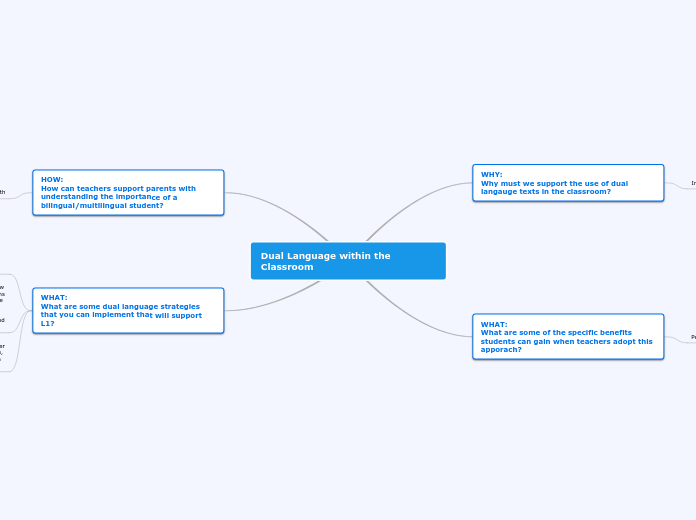Dual Language within the Classroom
WHY:
Why must we support the use of dual langauge texts in the classroom?
Inclusion
Integrates Student's Identity: Allows for student voice to be heard. By encouraging dual language texts, student can bring 'themselves" to the classroom- a space is created where their culture and lens of the world is not only welcomed but encouraged.
Sense of Belonging: Language and culture are connected to one another. This approach acknowledges that. Learning a new language should not lead to the erasure of their world, it should be in addition to it. This process reflects that. When students can see themselves in the classroom, they are more likely to participate and feel safe enough to take risks.
Accessing prior knowledge: It is important to meet the student where they are. By encouraging dual language texts in the class, teachers will be able to more accurately and effectively observe and assess this and set up steps to help transfer this knowledge/skills in English using their L1.
WHAT:
What are some of the specific benefits students can gain when teachers adopt this apporach?
Peformance
Emotional Well Being: Increase in student confidence and self-esteem. This will help in tackling feelings of anxiety and insecurity. Learning a new language can be extremely daunting, especially if the student feels they are not able to use or refer their first language. This can cause them to feel like they are not able to communicate their thoughts or feelings. By encouraging L1, students will feel more capable and encourage them to explore new information with a lens they feel comfortable with.
Academic Performance: As noted before, learning a new language also comes with learning a new culture. This is a time of significant transition with a lot of unknown and uncertainty to navigate through. L1 can be used as a bridge- their first language acts as something they can hold onto, especially when they feel lost, overwhelmed or like they are about to fall/shut down. L1 needs to be viewed as a positive and enriching source of knowledge and understanding. This can then be used as a scaffolding method to help them develop their knowledge and skills in English.
HOW:
How can teachers support parents with understanding the importance of a bilingual/multilingual student?
Growth
Globalization: While English is a dominant language, it's important to discuss the benefits of being bilingual. By holding onto their L1, long term, students are more likely to be hired, connect with others, etc.
Understanding: Take time to discuss the plan and the student's progress. Parents want their kids to be successful- to strive and to be ready to take on the challenges of the world. By taking time to go over the benefits of using this approach and showing these results, parents will be able to help with this process.
WHAT:
What are some dual language strategies that you can implement that will support L1?
Reading: Provide readings in L1 that connect/related to the texts read in English. Provide translations and/or key vocabulary banks.
Technology: Encourage and allow technology use. Model how students can use technology, whether to translate or programs that helps sort ideas. For example: encourage students to use online programs that can take a long/difficult text and summarize and/or simplify it. This will then allow them to focus only on the main ideas verses trying to filter, decode and understand all at once.
Peers/Groups: Encourage students to work together whether in paris or in groups. This will allow students to ask questions, develop oral and communication skills. This also helps build a more inclusive and welcoming classroom.
